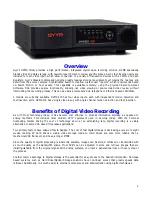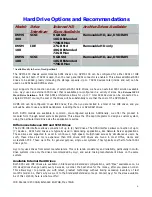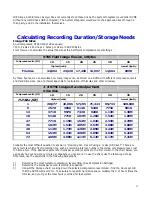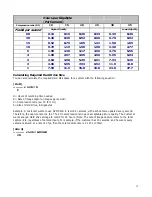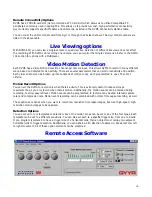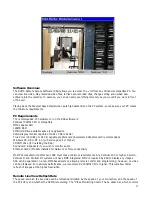
18
a)
Camera Switcher pulse connection between DVMS 100 and Mux.
b)
Regardless of Multiplexer used, you must “tell” DVMS how many cameras are connected to the Mux.
c)
Disable Multiplexer Activity Detection
d)
Multiplexer must be programmed to output only 1 picture per camera, in a consistent order (Gyyr DSP
Day/Night Sequence cannot be programmed to record more than 1 image/camera, and must sequence in
logical order)
First off, Image transmission performance is dictated by the recording parameters of DVMS. There is only a single
digitizing path, and if the DVMS is set to record at a slow rate, then transmission speed will be at a lower rate,
too.
If the DVMS 100/Mux is in Record mode, RAS will allow selected camera monitoring regardless of Multiplexer
used. In this mode, “Skip Decoding” is used. Because RAS “knows” how many cameras are on the system, it can
force DVMS to skip every camera except for the one desired for transmission. Basically, you have a Camera
UP/Down selection menu bar, which allows the user to switch to the previous or next camera view. You cannot
specifically recall a camera view based on camera number, because RAS cannot read the Multiplexer encoding
format in this mode. When the video window is first recalled, a random camera will be displayed. To request a
specific camera view, you would increment the UP or DOWN arrow selector until you get the camera you want.
If the DVMS 100/Mux is NOT Recording, nor playing back, RAS will NOT allow any live viewing. However, RAS
can request live transmission of a previously recorded video clip, and then selected camera playback is possible, if
a compatible Multiplexer is used. In this mode, “VITC Decoding” is used. As DVMS is downloading the clip, RAS
will read the Multiplexer coding, and display the selected camera view. In this mode, you CAN recall a camera
view based on camera number.
If a video clip (generated from a compatible Mux) has been retrieved and stored onto the RAS PC, then RAS can
replay the clip with greater control. These images are contiguous, and are randomly accessible. This clip can be
quickly reviewed at different speeds, forward or back.
RAS Capabilities using DVMS 100
W/ Compatible
Multiplexer
W/O Compatible
Multiplexer
Select Camera View Live While DVMS Recording
Yes
Yes
Select Camera View Live while DVMS Not Recording
No
No
Select Camera View during Playback, while DVMS Recording
Yes
No
Select Camera View during DVMS Playback
Yes
No
Select Camera View Playback from File on RAS PC Hard Drive
Yes
No
Ethernet Bandwidth Considerations
The Network bandwidth used by DVMS is dependent upon many factors. The communications are self-limiting,
and the data rate will decrease if there’s substantial traffic existing on the network.
If DVMS is set for maximum speed recording, say 60 fields per second, the transmission rate will be limited to
around 2 images per second. This will result in a lower data rate, and require less bandwidth on a network. If
DVMS is set for moderate speed recording, say around 15 fields/second, the image transmission rate can be up to
10 images/second. This will result in a higher data rate, requiring more bandwidth on a network.
If DVMS is on a 10 base T network without any other data traffic, it could possibly use 2-3 Mb/second. This is
perhaps half the bandwidth of a 10BaseT Ethernet, and could refresh images as fast as 20 fields/second. Real
world tests have been performed, and with a 10baseT network operating near peak capacity, DVMS limits to
around 70-80K Bytes/second. This results in around 4-5 images/second, at 20:1 compression. This is around 5-
7% of the bandwidth of a 10baseT network.

